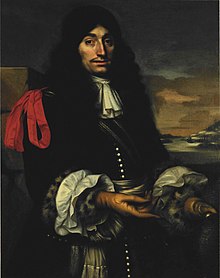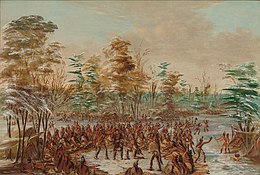Henri de Tonti
Henri de Tonti | |
|---|---|
 | |
| Co-founder of Fort St. Louis, Illinois country | |
| In office Founded 1682[1] | |
| Monarch | Louis XIV of France |
| Personal details | |
| Born | Enrico Tonti c. 1649 Gaeta |
| Died | September 1704 (aged c. 55) Fort Louis, Louisiana (present-day Mobile County, Alabama) |
| Cause of death | Yellow fever |
| Relations |
|
| Signature |  |
| Nicknames |
|
| Military service | |
| Allegiance | |
| Years of service | c. 1668–1676 |
| Rank | Captain |
| Battles | Franco-Dutch War |
Henri de Tonti (né Enrico Tonti; c. 1649 – September 1704), also spelled Henri de Tonty, was an Italian-born French military officer, explorer, and voyageur who assisted René-Robert Cavelier, Sieur de La Salle, with North American exploration and colonization from 1678 to 1686.[2] de Tonti was one of the first explorers to navigate and sail the upper Great Lakes. He also sailed the Illinois and the Mississippi, to its mouth and thereupon claimed the length of the Mississippi for Louis XIV of France.[3] He is credited with founding the settlement that would become Peoria, Illinois. De Tonti established the first permanent European settlement in the lower Mississippi valley, known as Poste de Arkansea, making him "The Father of Arkansas".[4][5]
Early life and military service
[edit]Henri de Tonti was born in Gaeta, c. 1649, to Lorenzo and Isabelle (née di Lietto) de Tonti.[4] His father was the governor of Gaeta and a Neapolitan banker. He is credited with inventing the tontine, a form of life insurance, though it has been suggested he merely modified existing Italian life insurance practices. Lorenzo was involved in a revolt against the Spanish viceroy in Naples, and the family was forced to seek asylum in France around the time of Henri's birth.[4] Henri's brother Alphonse was born in 1659, and later became one of the founders of what is now Detroit. Henri de Tonti's cousins, Daniel Greysolon Dulhut and Claude Greysolon de La Tourette were also able to build a name for themselves in New France.[6]
In 1668 around the age of 18, De Tonti decided to join the French service.[3] He was a cadet in the French Army for his first two years of military service. The following four years, De Tonti was a midshipman at Marseilles and Toulon and embarked on seven tours at sea, four of which were on warships and three were on galleys. He later became captain-lieutenant of the maître de camp in Messina. This was a troop that Louis XIV sent to Sicily in 1675 under the command of the Duke of Vivonne to support the rebellion of Messina (circa 100,000 inhabitants in 1674) during the Franco-Dutch War.
De Tonti took part in military operations in the village of Gesso, up the hills near Messina. He lost his hand in a grenade explosion, later replacing it with a metal appliance. He was also taken as a prisoner of war. After being detained for six months, De Tonti was exchanged for the Governor's son. After returning to France, De Tonti continued his deployment as a volunteer on the galleys. From that time on, wore a prosthetic hook covered by a glove, thus earning the nickname "Iron Hand". Among the officers fighting beside the French expedition corps, there were the brothers Antonio and Thomas Crisafy, who years later de Tonti will have the chance to meet again in New France. After the Franco-Dutch War, De Tonti was unable to obtain employment until recruited by La Salle, for exploration.[6]
New France
[edit]
In the summer of 1678, De Tonti journeyed to Quebec with René-Robert Cavelier, Sieur de La Salle; who recognized him as an able associate and thus named De Tonti his lieutenant. On August 27, Tonti and La Salle arrived in Gulf St. Lawrence. De Tonti described it as "A place extremely cold where no wheat grows".[7] On December 26 of the same year, de Tonti and La Salle reached the Niagara. De Tonti was left to supervise the construction of Fort Conti below Niagara Falls and the construction of the Griffon in early 1679 above the falls, which was to be the first ship to sail the Great Lakes.
In August 1679, De Tonti arrived at Fort Michilimackinac, the crossroads for southwestern fur trade, in which he discovered some of La Salle's crew had fled to and traded many livre's worth of goods. After rounding up the deserters, De Tonti sailed to the mouth of the St. Joseph and helped establish Fort Miami. Early in 1680. de Tonti also helped build Fort de Crèvecoeur in Illinois, which La Salle left de Tonti to hold while he returned to Ontario. While on his return trip up the Illinois, La Salle concluded that Starved Rock might provide an ideal location for another fortification and sent word downriver to de Tonti regarding this idea.
Following La Salle's instructions, de Tonti took five men and departed up the river to evaluate the suitability of the Starved Rock site. Shortly after de Tonti's departure, on April 16, 1680, the seven members of the expedition who remained at Fort de Crèvecoeur ransacked and abandoned the fort and began their own march back to Canada.[8] This opened up opportunity for Iroquois warriors to attack, stabbing de Tonti and forcing his men to retreat to Baie-des-Puants in late 1680.[3] In 1681, after recuperating from his injuries, De Tonti traveled to Fort Michilimackinac to rejoin La Salle.
Co-founder of Fort St. Louis, Illinois
[edit]
In the spring of 1682, de Tonti journeyed with La Salle on his descent down the Mississippi and helped establish alliances with Native Americans by presenting the calumet (a peace pipe) to the Natchez tribe, allowing La Salle to travel three leagues inland to meet with their chief.[9] Assuming they had made peace with the tribe, De Tonti tried to convince the Natchez to relocate near their new fort, Fort St. Louis, to conduct trade with one another. La Salle departed for France in 1683 to gather colonists for a new Louisiana venture, leaving de Tonti behind to hold Fort St. Louis.[6]
In La Salle's absence, Joseph-Antoine Le Febvre de La Barre, the governor of New France, confiscated all of La Salle's new territory. Barring de Tonti's aid in fighting off Iroquois attackers, de Tonti was no longer in command of the Illinois territory and was replaced by Louis-Henri de Baugy. de Tonti ventured back to Quebec in the spring of 1684.[7] La Barre later rescinded his decision to seize La Salle's territories, and De Tonti ventured back in 1685.[6]
Word reached De Tonti that La Salle was in the Gulf of Mexico, causing de Tonti to proceed to the south in 1686 to try to meet him on his ascent. Instead of meeting La Salle, De Tonti established a trading post in Arkansas, leaving six Frenchman to secure a permanent French settlement to trade with the Quapaw and to hinder English invasion in the east by establishing a presence in the middle of North America.[4]

In 1689, after receiving news that La Salle had been killed by his own men, de Tonti had begun journeying to La Salle's abandoned settlement in Baie Saint-Louis. Unfortunately, De Tonti was ill-prepared and turned back before he could reach the settlement and returned to Illinois.[6] In late winter 1690, resources grew scarce and he moved Fort St. Louis to Pimiteoui (present-day Peoria).[10] This new Fort St. Louis (also known as Fort Pimiteoui) later became the main trading post for the French.[11]
In the summer of 1685 Jacques-René de Brisay, Marquis de Denonville replaced La Barre as the governor of New France. Denonville decided that war with Iroquois was inevitable, promising Illinois "every protection" as well as consultation from De Tonti on military excursions. Denonville made de Tonti's key role in this military campaign, execution.[6] De Tonti was to mount an assault with 300 men from the rear of the Iroquois while Denonville launched a full frontal assault. De Tonti was unable to mount a large enough number of his men, so he joined with Sieurs de l'hut and de la Durantais at the front of the strait. de Tonti and the others proceeded to their rendezvous on Lake Ontario and met up with Denonville and took part in the van of the French attack against the Senecas.[6]
They later set a military post in Niagara. In 1687, De Tonti was engaged in wars with the English and their Iroquois allies. during this time, he was also able to conduct treaties with Native American tribes. In 1690, after he was granted La Salle's fur trading commission, de Tonti decided to aid French colonization in Illinois by engaging in trade. In the summer of 1697, he left Illinois in the care of his cousin Pierre de Liette.[6] De Tonti then commenced on a journey down the Mississippi to make contact with Pierre Le Moyne d'Iberville, who had established the Louisiana colony.[2] De Tonti reached Louisiana and joined the colony.[3]
Later life and death
[edit]Following this, De Tonti was offered by Pierre Moyne, Sieur d’Iberville the opportunity to work as a treaty negotiator and peacemaker. Working under Pierre Moyne, Sieur d’Iberville's brother Jean Baptiste Le Moyne de Bienville, De Tonti was able to bring peace between the Choctaw and Chickasaw nations of Louisiana and proceeded to receive aid from the two nations. The use of his appliance that replaced his hand led these tribes to believe he had special powers. De Tonti died in September 1704 from yellow fever.[6] It is believed that De Tonti's “remains were laid to everlasting rest in an unknown grave near the Mobile, and not far from the monument erected in 1902 to commemorate the site of old Mobile".[4]
References
[edit]- ^ museum.state.il.us website Home > Archeology > Starved Rock Site
- ^ a b "A tour of Mobile's first 100 years", staff reporter, The Press-Register, Mobile, AL, February 24, 2002
- ^ a b c d "Henri de Tonti". Encyclopædia Britannica. August 28, 2019.
- ^ a b c d e "Henri de Tonti (1649–1704)". Encyclopedia of Arkansas. 2011. Retrieved December 6, 2019.
- ^ HMdb.org, "Henri de Tonti Historical Marker", Natchitoches Parish, Louisiana. Retrieved August 9, 2009.
- ^ a b c d e f g h i Osler, E. B. (1982) [1969]. "Tonty, Henri (de)". Dictionary of Canadian Biography. Vol. II (1701-1740). Retrieved December 6, 2019.
- ^ a b Tonti, Henri (1704). "Relation of Henri de Tonty concerning the explorations of LaSalle from 1678 to 1683". Chicago: Caxton Club. pp. 1–121.
- ^ peoriahistoricalsociety.org, "Henri de Tonti, Founder of Peoria"
- ^ Mehta, Jayur (2013). "Spanish Conquistadores, French Explorers, and Natchez Great Suns in Southwestern Mississippi, 1542-1729". Native South. 6: 36. doi:10.1353/nso.2013.0002. S2CID 128574942 – via Project MUSE.
- ^ Mulkey, Floyd (December 1944). "Fort St. Louis at Peoria". Journal of the Illinois State Historical Society. 37 (4): 301–316. JSTOR 40188856.
- ^ The fort is distinct from the Fort St. Louis founded in French colonization of Texas.
External links
[edit]- 17th-century births
- 1704 deaths
- 17th-century French businesspeople
- 17th-century French diplomats
- 17th-century French writers
- 17th-century Roman Catholics
- 18th-century French diplomats
- 18th-century Roman Catholics
- Advocates of colonization
- American city founders
- American Indian Wars prisoners of war
- Deaths from yellow fever
- French amputees
- French colonial governors and administrators
- French explorers of North America
- French knights
- French male non-fiction writers
- French military officers
- French military personnel of the Franco-Dutch War
- French Roman Catholics
- Fur traders
- Infectious disease deaths in Alabama
- Italian emigrants to France
- Military personnel from Paris
- People from Gaeta
- People from Mobile County, Alabama
- People of Louisiana (New France)
- Writers from Peoria, Illinois
